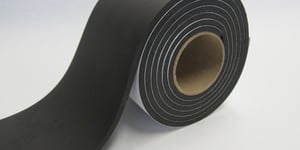Right when you’ve decided you need foam, a nagging search engine suggestion catches your eye: Should I use open-cell or closed-cell foam?
In any instance, you should choose the foam that suits your application to lessen its chances of failure. But before you panic, the difference is relatively simple.
As a flexible material converting company, we order foam on a weekly, if not daily, basis, which is why we will teach you how to choose the right foam cell.
After reading the advantages and disadvantages of open and closed cell foam, you’ll know which material will suit your project for maximum performance and efficiency.
What is the Difference Between Open Cell and Closed Cell Foam?
Open-cell and closed-cell foam are very different on a microscopic level.
Both types of foam are made up of individual cells that are either open, allowing air and moisture to pass through, or closed. The permeable (open) cells allow for more flexibility, whereas the sealed (closed) cells are arranged in a dense cluster to repel outside substances.
Open Cell Foam Advantages and Disadvantages
The air pocket structure of open cell foam allows for many unique advantages that make it ideal for specific applications.
However, flexibility and permeability aren’t always the desired effects for an application, so we’ll also discuss the potential drawbacks.
ADVANTAGES
The advantages of open-cell foam are as follows:
- Lightweight due to the air pockets
- Ability to expand in tight spaces
- Conforms to its surroundings
- Soundproofing and sound-dampening abilities
- Less expensive
Lightweight materials are utilized in many industries, including aerospace. In fact, lightweight soundproof materials like open-cell foam are particularly prominent in the commercial airline industry.
DISADVANTAGES
There are downsides to every material. Open-cell foam is:
- Less durable
- Vulnerable to moisture infiltration
- Lacking additional structural support
- Low heat resistance
Because it’s vulnerable to moisture, open-cell foam isn’t suited for sealing or outdoor use. Instead, it’s more commonly used in building or vehicle interiors, upholstery, and comfort applications.
You might ask yourself, “Can open cell foam get wet?”
While open cell foam CAN get wet, it has a higher chance of soaking up moisture which might disturb its functionality. It will also allow the moisture to pass through the foam. Before choosing open-cell, make sure your application doesn’t need to be water resilient.
Closed Cell Foam Advantages and Disadvantages
Closed cell foam is comprised of sealed cells that are watertight and airtight, making it dense, durable, and perfect for gasketing applications.
ADVANTAGES
You might choose closed-cell foam because it’s:
- Waterproof
- Highly durable
- Heat insulated
- Tear resistant
- Forms an airtight seal
- Has a longer lifespan
Closed-cell foam can be used outdoors on the exterior of buildings or vehicles. Additionally, it provides some structural support to the application because most of them are firm and don't tear easily. But, there are exceptions to the rule.
DISADVANTAGES
The downsides to closed cell foam are:
- More expensive
- Lower shock absorption
- Heavier
- Less conformable due to its rigidity
- Lower breathability
Because of the density and manufacturing process, closed cell foam tends to be more expensive. You may also note that the shock absorption is less due to its structure.
IS CLOSED CELL FOAM BETTER THAN OPEN CELL?
Closed cell isn’t inherently better than open cell foam. Instead, their worth depends on how you use them.
Using closed-cell foam could be the right choice if you have an application in need of waterproofing or weathering protection. Still, because it’s less conformable and more expensive than open cell, you’ll only want to use it if it makes sense for your product.
Should I Choose Open Cell or Closed Cell Foam?
Ultimately, the type of foam you choose will depend on the characteristics that fit your desired application.
Aside from open-cell and closed-cell foams, there are many foam materials to consider if you’re looking for a particular material for a product. For instance, PORON is a type of polyurethane foam that companies use for various applications. Many types of PORON foam are open-cell, but there is the occasional semi-closed-cell variety.
Do you know which type of foam you’re looking for? And if you do, do you know where to find it?
When you prototype with a converter, we can help you obtain sample quantities in your desired shape to test whether they suit your intended application.
Lastly, if you have any questions about which material might serve your product the best, you can ask us or have your part design evaluated by our team of engineers so you can be sure you’re choosing the right material to use effectively.







